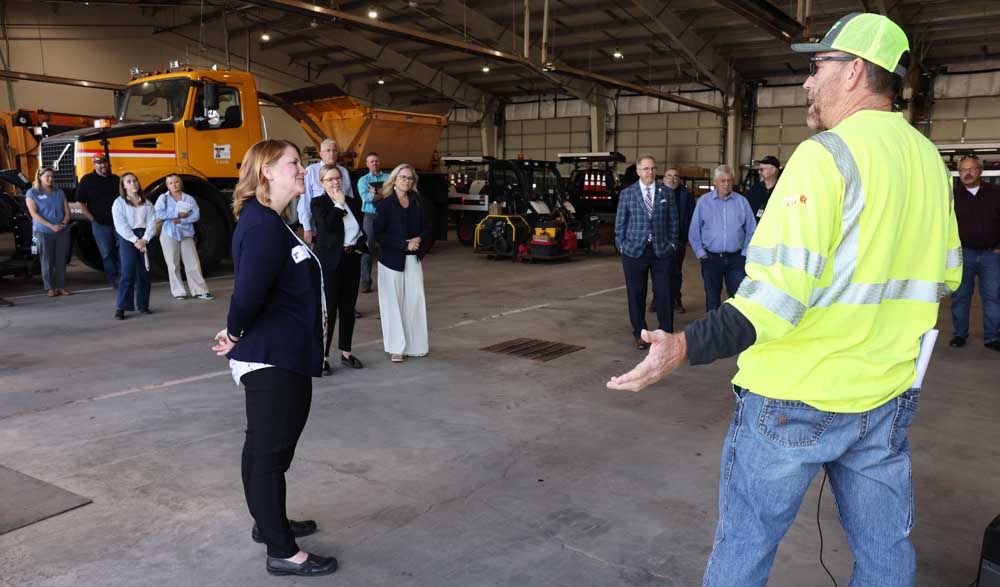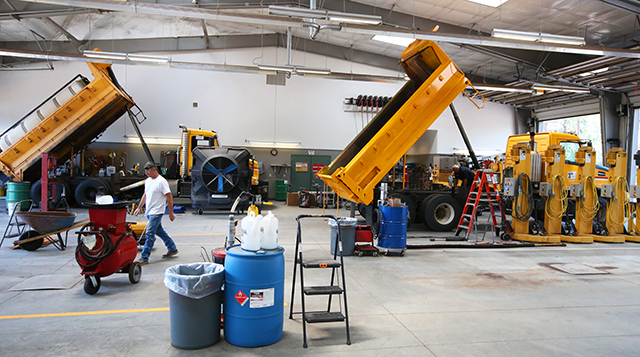ODOT budget woes could mean less plowing, safety, cleanup on Central Oregon roads
Published 5:30 am Tuesday, September 17, 2024

- Brad Stevens, Oregon Department of Transportation Region 4 electrical crew supervisor, right, speaks during a meeting of the Oregon Legislature’s Joint Committee on Transportation at the ODOT maintenance yard in Bend.
Oregon highway officials promise more potholes, rougher roads, longer closures and slower incident response without help from the Legislature in 2025.
They’re hopeful legislators will come up with solutions to the state’s transportation funding woes — though it’s not clear what that will look like.
Trending
“I think everything’s on the table,” said Rep. E. Werner Reschke, R-Klamath Falls, who represents south-central Oregon including areas just south of Bend. “We need to fund transportation. It’s one of those basics of government.”
Lawmakers on the Legislature’s committee on transportation have been touring the state to discover regional transportation needs, stopping in Bend last week to hear from representatives of city and county government, public transit agencies and local groups.
Transportation challenges mirror those from two decades ago
The looming cuts would only happen without a funding package in the 2025 legislative session, said Kacey Davey, a Central Oregon spokesperson for the Oregon Department of Transportation.
Trending
“We are all hopeful that sufficient and sustainable funding will be realized in the next legislative session to support a transportation system that is safe, accessible and reliable for everyone,” she said in an email.
“We will seek to minimize negative impacts on customers and the agency where we can, but the impacts starting in mid-2025 would be significant and unavoidable.”
ODOT’s woes
Declining gas tax revenue, high construction costs and restrictions to funding are all to blame, according to ODOT. The agency’s budget for maintenance has dwindled by 10% since 2021, resulting in cuts to staff and rollbacks in services, Davey said.
Deeper cuts were spared in 2023 by the Legislature, which bumped up DMV fees and provided a $19 million injection for winter maintenance through this winter.
Current funding projections for 2025-2027 fall $354 million short of what’s needed to maintain current staffing levels, according to an ODOT budget request from earlier this month. If the Legislature were to adopt the budget without additional funding, the agency would cut about a fifth of its workforce, or nearly 1,000 employees, including 116 in the Central Oregon region, which stretches from the Columbia River to the border with California.
Other parts of the state don’t face the same winter maintenance challenges as Central Oregon, said Jim Scholtes, maintenance director for highways from Burns to Bend to Prineville to Warm Springs. ODOT predicts it will be able to purchase half of the winter materials — salt, deicers and sand — for roads than in previous years.
“Winter maintenance is absolutely critical for our area here in Central Oregon,” Sisters Mayor Michael Preedin told legislators last week, adding that commerce relies heavily on mountain pass highways connecting Central Oregon with the Interstate-5 corridor.
Priority roads
Without more funding, ODOT would prioritize plowing on main highways like U.S. Highway 97, U.S. Highway 26 and U.S. Highway 20, Davey said. Plowing on less traveled roads, which make up 57% of state-maintained roads in Central Oregon, would take a hit.
Freezing temperatures, precipitation and studded tires carve gouges in heavily-used roads, Scholtes said. That’s the case on NE Greenwood Avenue just west of Pilot Butte in Bend, a section of Highway 20 that needs repairs every few years.
“You’re going to see those ruts really start to affect the safety of the road,” Scholtes said.
The upcoming legislative session will also have implications for roads maintained by the city of Bend. David Abbas, director of the city’s transportation and mobility department, said cities get 20% of the state’s fuel tax, which is not a sustainable source to keep up with demands on roads.
The city received $8.2 million in state fuel tax revenue last year.
Bend City Councilor Barb Campbell told legislators on Thursday her top priority for funding transportation is safety.
“Why do we need maintenance? So the roads are safe,” she said.
An increase of litter and debris on the road would also affect safety, Scholtes said. ODOT anticipates homeless camp cleanup would decrease by two-thirds without more funding. The agency has been active in clearing homeless encampments along Highway 97 in recent years, work that costs approximately $10,000 per day.
New data shows spike in homelessness spending amid ODOT-cutbacks
Reduced budgets would also give ODOT less opportunity to deliver on big projects, Davey said.







